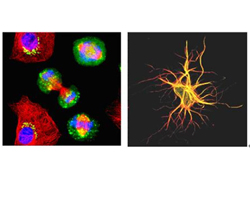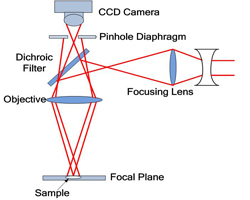Confocal Laser Scanning Microscopy
Confocal Laser Scanning Microscopy (CLSM) consists of confocal
microscopy, laser and data acquisition system. It is a combination of the
optical microscope, the modern laser technology, Raman detection technology,
scanning control technology, computer image processing technique and
fluorescence labeling technique. Its application and research field include the
observation of life living cell structure and specific molecular, Ion
biological changes, pharmacology, genetics, spectroscopy and related subjects.
Specific applications such as: stochastic optical reconstruction microscopy(STORM), fluorescence lifetime-transient
scanning(FLITS), fluoresence recover after photobleaching(FRAP), stimulated emission
depletion(STED)etc.
Changchun New Industries (CNI), founded in 1996, is a leading manufacturer of solid-state and diode laser systems. CNI laser features with high performance, nice reliability, and specifically designed for OEM, scientific, industrial and instrumentation use. In addition, CNI lasers are ISO-9001, FDA, CE, RoHS and JQA certified. CNI can provide different lasers for Confocal Laser Scanning Microscopy, High Resolution Fiber Optic Spectrometer, Optical Fiber Raman Probe, Fiber Coupler, modulator and other related accessories.
â– CNI self-developed high reliability lasers.
User requirements can be realized.
â– CNI can provide different lasers with free
space and Multi-wavelength single-mode fiber coupling, and related
Wavelengths: 266nm, 355 nm, 360 nm, 375 nm, 405 nm, 442 nm, 445 nm, 457 nm, 465 nm, 473 nm, 488 nm, 515 nm,
520 nm, 532 nm, 556 nm, 561 nm, 589 nm, 593 nm, 633 nm, 637 nm.640 nm, 671 nm., 690 nm, 720 nm,
750 nm, 785 nm, 808 nm, 1064 nm, 2200 nm etc.
Single
longitudinal mode, narrow linewidth, laser available;
Multi-wavelengths laser systems also available; New laser-wavelength can
be customized.
(1) Antimicrobial Photodynamic Efficiency of Novel Cationic Porphyrins
towards Periodontal Gram-positive and Gram-negative Pathogenic
Bacteria
(Photochemistry and
Photobiology, Volume 90, Issue 3, pages 628–640, May/June 2014) (CNI-635nm)
(2) Calcium Dynamics in Root Cells of Arabidopsis thaliana Visualized with
Selective Plane Illumination Microscopy (PloS one, 2013, 8(10):
e75646.) (CNI-442nm)
(Applied Optics, Vol. 53,
Issue 31, pp. 7177-7181 (2014)) (CNI-532nm)
Laser Pointing Pen,Laser Confocal Microscopy,Confocal Laser Scanning Microscopy,Microscopy Laser Changchun New Industries Optoelectronics Technology Co., Ltd. , https://www.cnioptics.com




Features
â– System is stable and reliable. Customized solution can be
provided upon request.
Laser Related
Accessories





Fiber Patech Cables
Spectrometer
Raman Probe
Power Meter
Laser Goggles
Applications of CNI laser for Confocal Laser Scanning Microscopy
(3) Fluoxetine induces vasodilatation of cerebral arterioles by
co-modulating NO/muscarinic signalling (Journal of Cellular and
Molecular Medicine, Volume 16, Issue 11, pages 2736–2744, November 2012) (CNI-532nm)
(4) Fluorescence ghost imaging with pseudothermal light (Optics Letters, Vol.
36, Issue 16, pp. 3302-3304 (2011)) (CNI-473nm)
(5) Improved Temporal Resolution and Linked Hidden Markov Modeling for
Switchable Single-Molecule FRE (ChemPhysChem, Volume
12, Issue 3, pages 571–579,February 25, 2011) (CNI-532nm)
(6) Near-field Raman imaging using optically trapped dielectric microsphere (Optics Express, Vol.
16, Issue 11, pp. 7976-7984 (2008)) (CNI-532nm)
(7) Ultra-high resolution Raman imaging by optically trapped dielectric
microsphere (NanoScience+
Engineering. International Society for Optics and Photonics, 2008:
70330E-70330E-7) (CNI-532nm)
(8) Luminescence enhancement in nanocomposite consisting of polyvinyl
alcohol incorporated gold nanoparticles and Nile blue 690 perchlorate
Oil giant targets second-generation biofuels
With growing environmental concerns, shifting government policies, and the depletion of easily accessible global oil reserves, major oil companies are increasingly turning their focus toward biofuels. The challenge now is not just maintaining current profitability but also cultivating future earnings in a rapidly evolving energy landscape. Over the years, biofuels have emerged as a promising solution to both environmental and energy crises, offering advantages in sustainability, renewability, and cost-effectiveness.
Beyond traditional oil exploration, leading oil corporations are now investing heavily in the expansion of biofuel production, market development, and next-generation fuel technologies. This shift reflects a broader recognition that biofuels are no longer a niche option but a key component of the future energy mix.
According to Aaron Brady from Cambridge Energy Consulting, “In the past, oil companies weren’t really invested in biofuel production. But that’s changing. They now see biofuels as a trend that will gain widespread acceptance.â€
More and more oil companies are stepping into the biofuel arena. ChevronTexaco has launched one of the first large-scale biodiesel plants in the U.S., while Marathon Oil recently became the first U.S. oil company in 30 years to invest in ethanol production. Shell is pushing forward with cellulosic ethanol, aiming for full commercialization.
Historically, the biofuel market was dominated by smaller players and agricultural cooperatives, whose facilities were much smaller than those of the big oil firms. However, this is changing. For example, ChevronTexaco is partnering with Galveston Bay Biodiesel to build a facility that can produce up to 100 million gallons of biodiesel annually—more than double the total U.S. biodiesel output from the previous year.
This move is driven not only by high oil prices but also by supportive government policies and public demand for cleaner energy. In the U.S., a recent energy bill mandates that ethanol content in gasoline rise to 7.5 billion gallons by 2012, while the EU aims for 5.8% of total fuel consumption to come from biofuels by 2010.
Countries around the world are developing their own biofuel strategies, using diverse raw materials. Brazil has successfully integrated sugarcane-based ethanol into its fuel supply, while the Philippines mandates the use of coconut oil in diesel. In the U.S., corn-based ethanol is added to gasoline, and soybean oil is used in diesel. In Europe, rapeseed oil is commonly used for biodiesel.
Sergio Trindad from International Fuels Technologies notes, “The advantage of these additives is that they come from different sources, which can be grown globally.†This diversity helps reduce dependency on any single region or crop.
Despite the potential benefits, the expansion of biofuels faces significant challenges, particularly in balancing food production with fuel production. Using non-food biomass like plant waste for ethanol is more efficient and sustainable than relying on food crops. Robin West from PFC Energy Consulting believes that solving this issue will take time, especially if we want to ensure long-term sustainability in the energy sector.
Major oil companies are aware of these challenges and are focusing on long-term strategies rather than short-term gains. ExxonMobil’s Duff Gardner states, “Biofuels will play an important role in meeting U.S. energy needs, but they must overcome technical hurdles to compete effectively with fossil fuels without subsidies.â€
To achieve this, companies like ExxonMobil and BP are investing in next-generation biofuels. BP is collaborating with DuPont to develop advanced biofuel technologies, while Shell is working with multiple partners to explore new options, including cellulosic ethanol and advanced bio-components for diesel engines.
Donald Paul of ChevronTexaco sees this as a new phase in the industry: “This is a new stage, and our ultimate goal is to build a large-scale infrastructure for sustainable biofuels.†As the energy transition continues, the role of biofuels is set to grow, shaping the future of global fuel markets.
